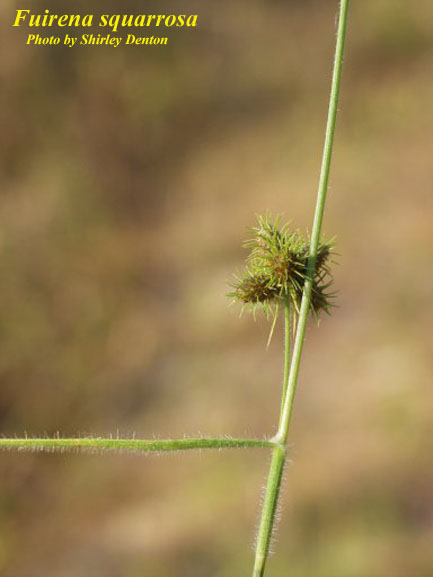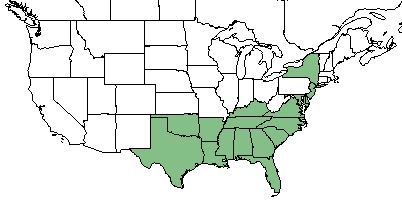Difference between revisions of "Fuirena squarrosa"
Juliec4335 (talk | contribs) |
|||
| Line 33: | Line 33: | ||
Associated species - ''Eleocharis tuberculosa'', ''Gentiana saponaria'', ''Bartonia paniculata'', ''Platanthera cristata'', ''Pyrus arbutifolia'', and ''Viburnum nudum'' <ref name= "Bridges"> Bridges, E. L. and S. L. Orzell (1989). "Syngonanthus flavidulus (Eriocaulaceae) new to Mississippi." SIDA, Contributions to Botany 13(4): 512-515. </ref>. | Associated species - ''Eleocharis tuberculosa'', ''Gentiana saponaria'', ''Bartonia paniculata'', ''Platanthera cristata'', ''Pyrus arbutifolia'', and ''Viburnum nudum'' <ref name= "Bridges"> Bridges, E. L. and S. L. Orzell (1989). "Syngonanthus flavidulus (Eriocaulaceae) new to Mississippi." SIDA, Contributions to Botany 13(4): 512-515. </ref>. | ||
| + | |||
| + | ''Fuirena squarrosa'' is an indicator species for the Panhandle Seepage Savannas community type as described in Carr et al. (2010).<ref>Carr, S.C., K.M. Robertson, and R.K. Peet. 2010. A vegetation classification of fire-dependent pinelands of Florida. Castanea 75:153-189.</ref> | ||
===Phenology=== <!--Timing off flowering, fruiting, seed dispersal, and environmental triggers. Cite PanFlora website if appropriate: http://www.gilnelson.com/PanFlora/ --> | ===Phenology=== <!--Timing off flowering, fruiting, seed dispersal, and environmental triggers. Cite PanFlora website if appropriate: http://www.gilnelson.com/PanFlora/ --> | ||
Revision as of 19:25, 31 July 2020
Common name: hairy umbrella-sedge; salt-marsh umbrellagrass
| Fuirena squarrosa | |
|---|---|

| |
| Photo by the Atlas of Florida Plants Database | |
| Scientific classification | |
| Kingdom: | Plantae |
| Division: | Magnoliophyta - Flowering plants |
| Class: | Liliopsida - Moncots |
| Order: | Poales |
| Family: | Cyperaceae |
| Genus: | Fuirena |
| Species: | F. squarrosa |
| Binomial name | |
| Fuirena squarrosa Michx. | |

| |
| Natural range of Fuirena squarrosa from USDA NRCS Plants Database. | |
Contents
Taxonomic Notes
Synonyms: Fuirena hispida Elliott
Description
F. squarrosa is a native perennial graminoid that is a member of the Cyperaceae family [1]. Species in this family grow reproductive units in the form of spikelets, which contain highly simplified flowers [2]. F. squarrosa has alternate simple leaves shaped linearly, and contains a fibrous root structure like most Monocots. The inflorescence is a spikelet, like other grasses, and the perianth contains bristles.[3]
Distribution
The species can be found in the Southeast United States, ranging from Texas to Virginia, as well as in the Northeast in Maryland, New Jersey, and New York [1]. It becomes more rare in communities located in Tennessee, Delaware, and New Jersey [4]. Although it is mainly distributed along the southeastern coastal plain, it is less strictly limited than other species.[5]
Ecology
Habitat
F. squarrosa can be found in mesic communities, including sphagnous bogs, [6] and can be found infrequently in pine-palmetto communities and wet prairies [7]. As well, F. squarrosa is present in habitats ranging from wet sandy loams of roadside depressions and other wet loamy sand disturbed sites. [8] In the New York coastal plain ponds, F. squarrosa is seen to be restricted to pond-shores, and is only observed in low water years.[9] It is listed by the USDA Natural Resources Conservation Service as an obligate wetland species, where it only occurs in wetland habitats.[1] As well, F. squarrosa is considered an indicator species of panhandle seepage savannas in north Florida.[10]
Associated species - Eleocharis tuberculosa, Gentiana saponaria, Bartonia paniculata, Platanthera cristata, Pyrus arbutifolia, and Viburnum nudum [6].
Fuirena squarrosa is an indicator species for the Panhandle Seepage Savannas community type as described in Carr et al. (2010).[11]
Phenology
This species generally flowers from July until October.[5] This bloom time also denotes the fruiting period for F. squrrosa.[3] Flowering time ranges continuously from August until October, while fruit development has been seen in the months of May and October. [8]
Fire ecology
Sphagnous bogs and other similar communities are fire dependent due to their high acidity, which makes F. squarrosa dependent on fire frequency [12].
Use by animals
This species is considered to be of poor foraging quality.[13]
Conservation and Management
This species is listed as threatened by the Michigan Department of Natural Resources, Natural Features Inventory, and is listed as a species of special concern by the Tennessee Department of Environment and Conservation, Natural Heritage Program.[1]
Cultivation and restoration
Photo Gallery
References and notes
- ↑ 1.0 1.1 1.2 1.3 USDA Plants Database URL: https://plants.usda.gov/core/profile?symbol=FUSQ
- ↑ Reutemann, A. G., Vegetti, A. C., and Pozner, R. Inflorescence development in Abildgaardieae (Cyperaceae, Cyperoideae). Flora 210: 3-12.
- ↑ 3.0 3.1 Ladybird Johnson Wildflower Center URL: www.wildflower.org
- ↑ NatureServe Explorer URL: http://www.natureserve.org/explorer/
- ↑ 5.0 5.1 Weakley, A. S. (2015). Flora of the Southern and Mid-Atlantic States. Chapel Hill, NC, University of North Carolina Herbarium.
- ↑ 6.0 6.1 Bridges, E. L. and S. L. Orzell (1989). "Syngonanthus flavidulus (Eriocaulaceae) new to Mississippi." SIDA, Contributions to Botany 13(4): 512-515.
- ↑ Hilmon, J. B. (1964). "Plants of the Caloosa Experimental Range " U.S. Forest Service Research Paper SE-12
- ↑ 8.0 8.1 Florida State University Robert K. Godfrey Herbarium database. URL: http://herbarium.bio.fsu.edu. Last accessed: June 2018. Collectors: Loran C. Anderson, Ed Keppner, Lisa Keppner, Travis MacClendon, Karen MacClendon, George Wilder, J. Roche, R. A. Norris, Helen Roth, Floyd Griffith, and Richard Carter. States and counties: Florida: Putnam, Bay, Calhoun, Leon, Gadsden, and Jackson. Georgia: Brantley.
- ↑ Zaremba, R. E. and E. E. Lamont (1993). "The status of the coastal plain pondshore community in New York." Bulletin of the Torrey Botanical Club 120(2): 180-187.
- ↑ Carr, S. C., et al. (2010). "A Vegetation Classification of Fire-Dependent Pinelands of Florida." Castanea 75(2): 153-189.
- ↑ Carr, S.C., K.M. Robertson, and R.K. Peet. 2010. A vegetation classification of fire-dependent pinelands of Florida. Castanea 75:153-189.
- ↑ Campbell, C. S. (1983). "Systematics of the Andropogon virginicus complex (Gramineae)." Journal of the Arnold Arboretum 64(2): 171-254.
- ↑ Hilman, J. B. (1964). "Plants of the Caloosa Experimental Range " U.S. Forest Service Research Paper SE-12